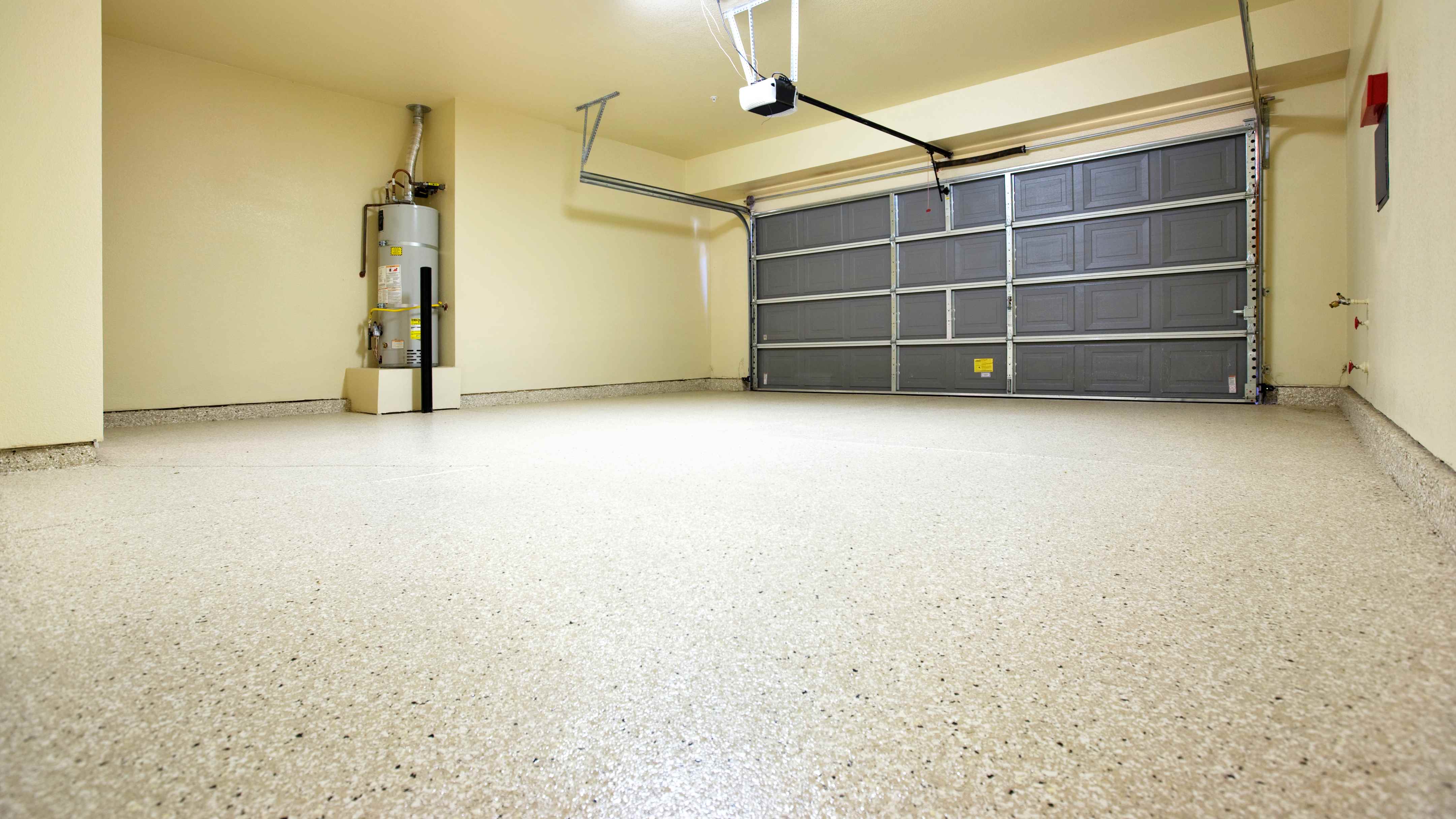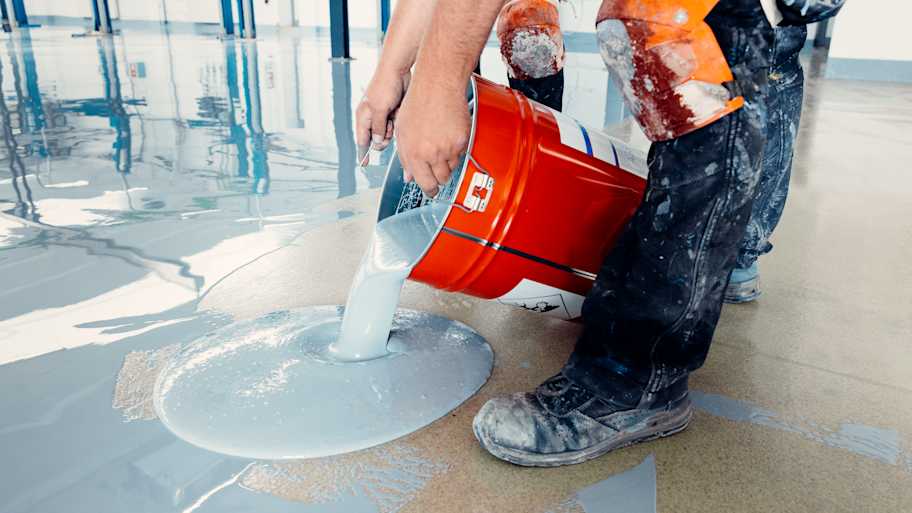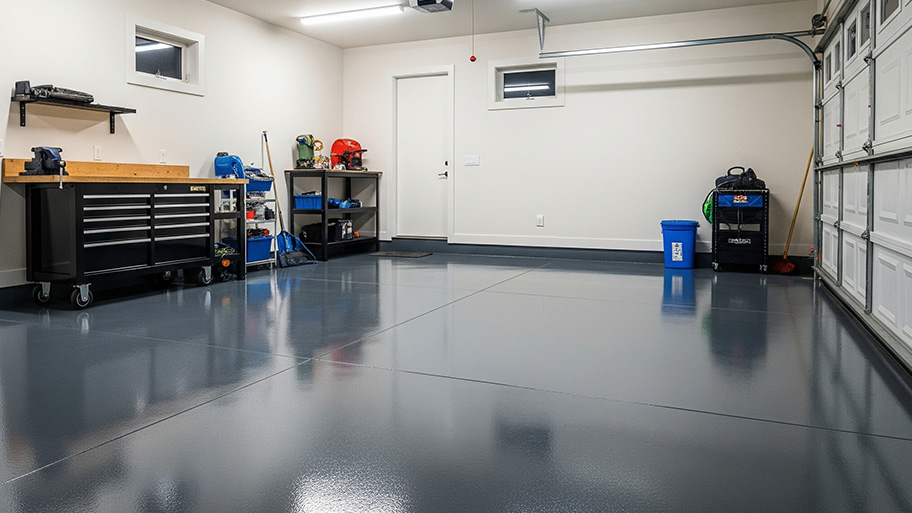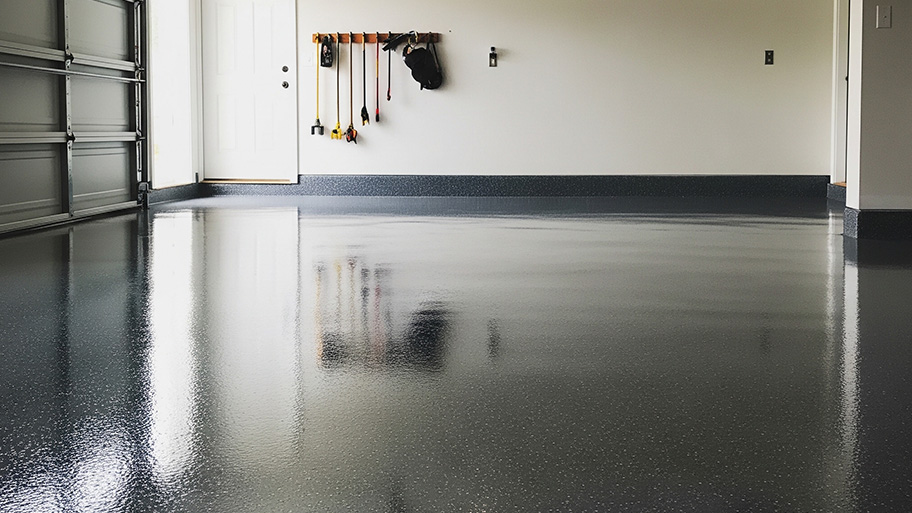
Garage floor replacement costs $2,200 on average but can vary depending on several factors. Review our guide for a more accurate estimate.
Durable, dazzling, and easy to clean, but watch out for finicky installation


Epoxy floors are made from resin mixed with a hardener to create a durable flooring surface.
These floors are durable, resistant to chemicals and moisture, and available in various colors and designs.
During the curing process, epoxy floors are sensitive to hot and cold temperatures.
Epoxy formulas vary in composition, with options to enhance strength, durability, and resistance to damage.
The pros and cons of epoxy flooring need careful consideration based on use, traffic, and your budget. While proper installation is crucial to the success and longevity of an epoxy floor, these floors can last for decades. These tough floors give you some creative and cost-effective options for high-traffic areas. A flooring pro can recommend an epoxy floor for your home or suggest an alternative.
Epoxy floors are made by combining a resin (Part A) with a hardener (Part B). Mixing the two creates a hard, solid surface that bonds with the materials underneath it, like concrete. Strength and durability depend on the type of resin, hardener, additives, or coatings. The variation in composition also affects the cost of the epoxy floor.
To clarify some terms, you might hear “epoxy floor” and “epoxy floor coating” used interchangeably. They’re similar but not exactly the same. The difference lies in the thickness of the epoxy. An epoxy floor is at least 2 millimeters thick, and epoxy floor coatings are anything thinner than that.
| Pros of Epoxy Flooring | Cons of Epoxy Flooring |
|---|---|
| Durability and longevity | Complex installation |
| Chemical and stain resistance | Long curing time |
| Easy to clean and maintain | Difficult to repair or replace |
| Customization options | Off-gassing |
| Can cover hard concrete floors | Sensitive to extreme temperatures and UV damage |

Epoxy floors are common in commercial and industrial buildings. However, the material has made its way into the residential market, thanks to an attractive list of benefits.
Epoxy floors can handle high impacts and heavy loads while resisting chipping, scratching, and abrasions. With proper care and maintenance, they can last 20 years or longer.
Epoxy’s resistance to damage makes it a go-to flooring material in high-traffic areas, garages, and shops where motor oil and certain types of chemicals are used. However, not all types of epoxy have the same durability. Pay attention to how durable and damage-resistant the epoxy will be over time.
Many, though not all, epoxy resins resist staining and chemical damage. Resistance to this type of damage can be improved by using the right resin and hardener, and ensuring that the temperature and length of exposure are ideal.
Epoxy floor maintenance is simple, as daily sweeping or vacuuming is enough to keep it clean. The floor is smooth, so dust and debris don’t get caught in cracks and crevices. You can use diluted degreasers to remove greasy stains and small amounts of acetone for stubborn marks. If anything gets dried and stuck, a plastic scraper can remove it without scratching the surface. However, you need to use pH-neutral cleaners to prevent dulling the epoxy.
Epoxy floors can be customized in several ways, from adding metal flecks or marbling to adding nonslip coatings. A wide range of color choices, mixes, and blends can adjust the final look based on what you need the floor to accomplish in the space.
Epoxy can adhere to concrete, so it can easily be used in utility areas where you wouldn’t use other types of flooring but would like to protect the concrete. The chemical and stain resistance can be better than that of concrete alone, so you can make the flooring in these spaces more durable.

While epoxy offers several benefits, it also has some downsides. However, many of these issues can be minimized or avoided by hiring a professional and selecting the right epoxy formula for the room's conditions and purpose.
Successful installation requires careful preparation, including cleaning, etching, and repairing the subfloor before mixing the resin and hardener. Additionally, environmental conditions need to be within specific temperature and humidity ranges for epoxy to adhere and cure. Most homeowners will save time and money by hiring a local garage floor coating pro with extensive experience in epoxy floor installation.
Epoxy floors can take 24 to 72 hours to cure, with some mixtures requiring up to a week to reach full strength. You won’t be able to use the floors during that time.
Epoxy installation creates a strong bond to the subfloor. If the epoxy becomes damaged and needs repair or you decide to replace it with something else, removal is challenging. Repairs can also be difficult and may be noticeable, even with professional help.
Epoxy releases unpleasant, and in some cases, harmful odors that can cause eye and throat irritation. It can also potentially cause skin irritation or aggravate asthma symptoms. Installation should be done in a well-ventilated space. You can also opt for low-VOC (Volatile Organic Compounds) formulas.
Epoxy can become soft and almost tacky in extremely high temperatures. At the other end of the spectrum, it can become brittle and crack or flake in extremely cold conditions. As mentioned previously, there are additives and formulas that can offer more protection against temperature-related damage.
Some epoxy formulations may discolor or yellow with exposure to direct UV light. However, there are formulas designed for outdoor and prolonged UV exposure.
Epoxy isn’t the only highly durable flooring with a smooth, sleek surface. Your plan for how to use the space can help you decide if these alternatives would better fit the needs of your project:
Painted, polished, or stained concrete: Painted, stained, or polished concrete has good durability, although it lacks some of epoxy’s stain and chemical resistance. Chemical-resistant paints and stains can increase the durability of these floors.
Polyurea coatings: These coatings are expensive, but they counter some of epoxy’s weaknesses. For example, they’re UV stable, cure faster, harden more, and have better impact, abrasion, and slip resistance.
Polyaspartic coatings: Polyaspartic coatings are similar to polyurea in that they’re durable, UV stable, and cure quickly. They’re used on both indoor and outdoor concrete surfaces.
Polyurethane concrete: More commonly found in industrial spaces, this high-end flooring can withstand thermal shock, heavy impact, and exposure to certain chemicals.
Rubber flooring: Rubber flooring is effective for sound and impact absorption. However, it’s better for spaces with foot rather than vehicle traffic.
Epoxy floors are an excellent choice for garages, basements, workshops, kitchens, and outdoor patios. You’ll get the best results by working with an experienced pro who can install them properly. They can recommend the right mixture and ensure the right conditions during installation.
However, epoxy doesn’t work for every project. Your budget might limit the epoxy mixtures available to you. Be sure to choose an epoxy that can withstand the type of wear and tear you expect the space to endure—such as supporting heavy machines in a workshop or undergoing heavy foot traffic on a patio.
From average costs to expert advice, get all the answers you need to get your job done.

Garage floor replacement costs $2,200 on average but can vary depending on several factors. Review our guide for a more accurate estimate.

Sealing concrete floors, patios, walkways, and driveways can keep them looking fresh for far longer. Let's break down the cost to seal concrete with a pro or on your own.

This guide breaks down the cost of installing epoxy flooring in your garage, basement, or other space. Costs depend on resin type, floor size, and more.

Looking for a way to update your concrete garage floor on a budget? From epoxy paint coatings to rubber and carpet tiles, explore the pros and cons of the top affordable garage flooring ideas, and compare prices using our helpful guide.

Whether you’re installing an epoxy floor or epoxy countertop, this calculator will help you determine how much epoxy you need to complete your project.

Want to give your worn-out garage floor a makeover? Learn how to apply an epoxy floor coating with this simple guide.